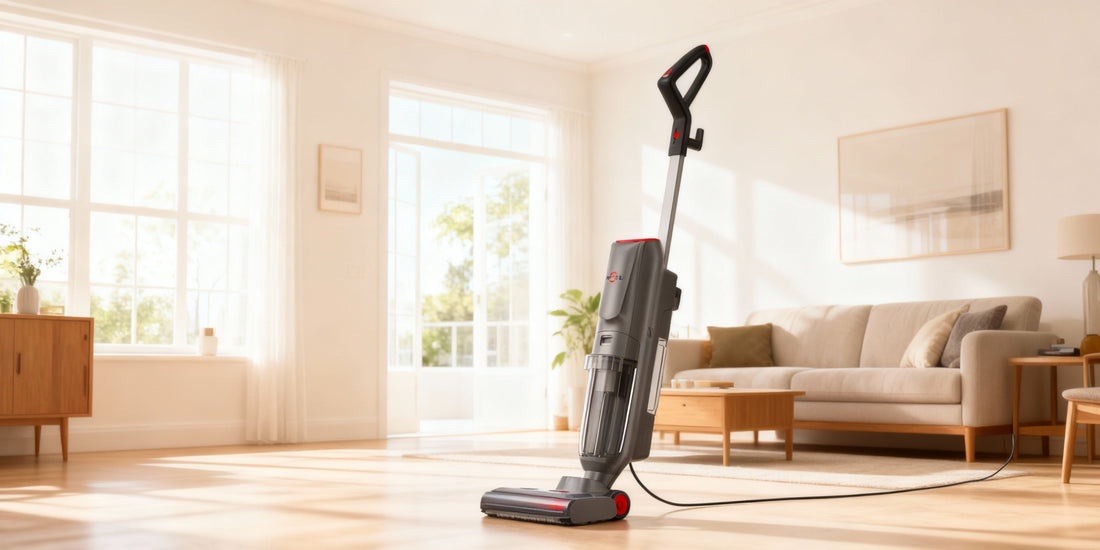
How Long Should a Cordless Vacuum Run to Clean My Flat? (Area, Time & Battery Guide for Indian Homes)
Share
If you’re buying your first vacuum and wondering, “How long will it take to clean my 2000sq-ft flat, and how much battery do I need?” — this guide gives you simple formulas, ready-reckoner tables, and a practical cordless vs corded recommendation for Indian homes. We’ll also show how short on-demand sessions reduce the need for one long cleaning block.
The one-minute formula
Step 1 — Estimate cleaning time
Time (minutes) = Flat area (sq ft) ÷ Cleaning rate (sq ft/min)
Step 2 — Add buffer
Battery minutes required ≈ Time × 1.15 (adds ~15% for turns, furniture, and tank swaps/self-clean)
Pick a realistic cleaning rate
- Quick daily tidy (Eco): 50 sq ft/min
- Standard clean (Auto): 35 sq ft/min
- Deep/Boost zones: 25 sq ft/min
Tip: For wet & dry floor-washers, keep the 15% buffer. If your home has many obstacles, use 20%.
Ready-reckoner (flat size → time → battery)
Assumes a standard pass at 35 sq ft/min. Buffer already included.
| Flat size (sq ft) | Approx time (min) | Battery minutes to budget |
|---|---|---|
| 600 | ~17–19 | 20–22 |
| 800 | ~23–24 | 26–28 |
| 1,000 | ~29–30 | 33–35 |
| 1,200 | ~34–37 | 40–43 |
| 1,550 (≈144 m²) | ~44–51 | 51–59 |
| 1,800 | ~51–58 | 60–67 |
If you plan lots of Boost or have rugs/pet zones, plan those areas at ~25 sq ft/min and add them separately.
Examples you can copy
1) 1,000 sq ft, quick daily tidy
Rate = 50 sq ft/min → Time = 1,000 ÷ 50 = 20 min
Battery ≈ 20 × 1.15 = 23 min
2) 1,200 sq ft, standard clean
Rate = 35 sq ft/min → Time = 1,200 ÷ 35 = 34.3 min
Battery ≈ 34.3 × 1.15 ≈ 40 min
3) 1,550 sq ft (≈144 m²), mixed clean
1,300 sq ft at 35 → 1,300/35 = 37 min
250 sq ft Boost zones at 25 → 250/25 = 10 min
Total time = 47 min → Battery ≈ 47 × 1.15 = 54 min
Cordless vs corded — which should I choose?
Cordless (daily convenience)
- Best at: 2–4 short sessions (3–15 min) through the day — kitchen after meals, hallway dust, pet hair.
- Battery planning: Use the table above. If your standard clean is 40–60 minutes, split into zones or consider a spare battery (if supported).
- Why it’s easier: You won’t “save mess for later.” Short on-demand sessions keep floors consistently clean and reduce the need for one long block.
Corded (unlimited runtime)
- Best at: Single, longer sessions (e.g., weekly deep clean) with stable suction and no runtime limit.
- Reach: A 5–6 m cable typically covers most rooms from a nearby plug; re-plugging is minimal in many Indian flats.
- Good pairing: Use corded for deep cleans; cordless for quick daily maintenance.
Quick chooser for common flat sizes
- ≤ 1,000 sq ft: Cordless is enough for a single pass (Eco/Auto) or two short sessions.
- 1,001–1,500 sq ft: Cordless (zonal/on-demand) or corded (single session). Choose based on your routine.
- ≥ 1,500 sq ft: Corded for the weekly deep clean; cordless for daily upkeep.
FAQ
Q. Can a cordless clean my whole 1,500+ sq ft flat in one go?
A. Yes if the battery spec meets your calculated need (~50–60 minutes). Many families prefer splitting into 2–3 short sessions or pairing with a corded unit for the weekly deep clean.
Q. How do wet & dry floor-washers affect timing?
A. They add small pauses for tank swaps and a brief self-clean — the 15% buffer in our formula covers this for most homes.
Q. What about Boost mode for rugs/pet corners?
A. Estimate those areas separately at ~25 sq ft/min, add to your total, then apply the 15% buffer.
Q. Which is easier for house help?
A. Cordless for quick, low-effort sessions; corded for longer passes with stable power. Most helpers adapt quickly to both.
Disclaimer: Cleaning rates, times, and battery estimates shown here are based on Atvel’s internal product testing under controlled conditions. There is no industry-wide standard for measuring these figures. Actual results will vary by home layout, floor type, soil level, obstacles, cleaning mode, operator technique, accessory condition, and battery health. Use these numbers as general guidance, not guarantees.